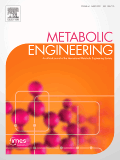|
Autors/es
Orive-Milla, Nuria ; Delmulle, Tom; De Mey, Marjan; Faijes, Magda ; Delmulle, Tom; De Mey, Marjan; Faijes, Magda ; Planas, Antoni ; Planas, Antoni
|
Abstract
Glycolipids are target molecules in biotechnology and biomedicine as biosurfactants, biomaterials and bioactive molecules. An engineered E. coli strain for the production of glycoglycerolipids (GGL) used the MG517 glycolipid synthase from M. genitalium for glucosyl transfer from UDPGlc to diacylglycerol acceptor (Mora-Buyé et al., 2012). The intracellular diacylglycerol pool proved to be the limiting factor for GGL production. Here we designed different metabolic engineering strategies to enhance the availability of precursor substrates for the glycolipid synthase by modulating fatty acids, acyl donor and phosphatidic acid biosynthesis. Knockouts of tesA, fadE and fabR genes involved in fatty acids degradation, overexpression of the transcriptional regulator FadR, the acyltransferases PlsB and C, and the pyrophosphatase Cdh for phosphatidic acid biosynthesis, as well as the phosphatase PgpB for conversion to diacylglycerol were explored with the aim of improving GGL titers. Among the different engineered strains, the ΔtesA strain co-expressing MG517 and a fusion PlsCxPgpB protein was the best producer, with a 350% increase of GGL titer compared to the parental strain expressing MG517 alone. Attempts to boost UDPGlc availability by overexpressing the uridyltransferase GalU or knocking out the UDP-sugar diphosphatase encoding gene ushA did not further improve GGL titers. Most of the strains produced GGL containing a variable number of glucosyl units from mono-to tetra-saccharides. Interestingly, the strains co-expressing Cdh showed a shift in the GGL profile towards the diglucosylated lipid (up to 80% of total GGLs) whereas the strains with a fadR knockout presented a higher amount of unsaturated acyl chains. In all cases, GGL production altered the lipidic composition of the E. coli membrane, observing that GGL replace phosphatidylethanolamine to maintain the overall membrane charge balance.
|

WoS
Scopus
Altmetrics
 
|
